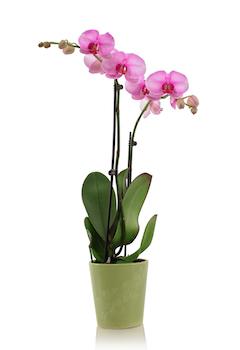
When it comes to orchid care, it doesn’t get any easier than three ice cubes a week. But unlike other flowers, orchids go through several changes during their lifecycle. Here’s what you need to know to keep your orchid thriving through every phase of its life.
Once you’ve selected the right orchid for you, place it in a well-lit environment. This can be in a brightly lit room or near a windowsill. Don’t worry if you don’t have a room with natural light: Orchids also thrive in environments with artificial light.
Orchids enjoy warm environments — between 60 and 80 degrees Fahrenheit — so the temperature of your home is important for your plant. If you want to brighten up your bathroom, try placing your orchid on the counter or on a windowsill. Orchids love the humidity common to most bathrooms, so adding your plant to this unlikely room will add some flair to a space that often gets overlooked. Looking for more places to put your plant? Try these ideas.
Besides a few ice cubes a week, there isn’t a lot you need to do to keep your plant healthy and blooming. You could add fertilizer to your orchid care routine, but it’s not required. For more tips on fertilizing, take a look at this step-by-step guide.
Taking a look at your orchid’s roots is an easy way to tell how healthy it is. Keep these pointers in mind when assessing the roots:
Evaluating the color of your orchid’s leaves is also helpful in determining the plant’s health. Here are some tips for checking your orchid’s leaves:
Like humans, orchids need a period of rest to get rejuvenated. It’s during this resting period orchids stockpile nutrients and energy so they can bloom again. You can tell your orchid is resting if all of its blooms have fallen off and the stalk has turned brown. Observing this process might make you think your plant has died, but don’t throw it out! It’s likely just resting, which is normal. During this resting time, all you need to do is continue your care routine like you did when your orchid was blooming. It can take several months for a new spike to grow, so remember to be patient.
Caring for orchids has never been easier. Get everything you need to know about caring for your orchid — from bringing it home, to fertilizing it, to repotting and more — in our latest guide.


Copyright Just Add Ice® Orchids 2023